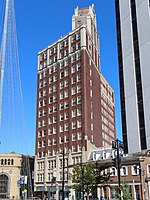Leopold Street Shule
Former synagogues in New York (state)Monroe County, New York Registered Historic Place stubsNational Register of Historic Places in Rochester, New YorkNew York (state) religious building and structure stubsReligious buildings and structures in Rochester, New York ... and 3 more
Synagogues completed in 1886Synagogues on the National Register of Historic Places in New York (state)United States synagogue stubs

Leopold Street Shule is a historic synagogue located at Rochester in Monroe County, New York. It was built in 1886 and is a rectangular brick building set on a high cut stone foundation measuring 45 feet by 85 feet. It was built by Eastern European Jews affiliated with the orthodox Beth Israel Congregation. In 1973, the former synagogue was purchased by the Church of God and Saints of Christ, a Hebrew Israelite congregation.It was listed on the National Register of Historic Places in 1974.
Excerpt from the Wikipedia article Leopold Street Shule (License: CC BY-SA 3.0, Authors, Images).Leopold Street Shule
Leopold Street, City of Rochester
Geographical coordinates (GPS) Address Nearby Places Show on map
Geographical coordinates (GPS)
| Latitude | Longitude |
|---|---|
| N 43.164722222222 ° | E -77.604444444444 ° |
Address
Leopold Street 30
14605 City of Rochester
New York, United States
Open on Google Maps










